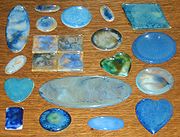
Ruskin Pottery
Encyclopedia



Edward R. Taylor
Edward Richard Taylor RBSA was an English artist and educator. He painted in both oils and watercolours.Taylor taught at the Lincoln School of Art and became influential in the Arts and Crafts movement as the first headmaster at the Birmingham Municipal School of Arts and Crafts from 1877-1903.In...
, the first Principal of Birmingham School of Art
Birmingham School of Art
The Birmingham School of Art was a municipal art school based in the centre of Birmingham, England. Although the organisation was absorbed by Birmingham Polytechnic in 1971 and is now part of Birmingham City University's Birmingham Institute of Art and Design, its Grade I listed building on...
, to be run by his son, William Howson Taylor, formerly a student there. It was named after the artist, writer and social thinker John Ruskin
John Ruskin
John Ruskin was the leading English art critic of the Victorian era, also an art patron, draughtsman, watercolourist, a prominent social thinker and philanthropist. He wrote on subjects ranging from geology to architecture, myth to ornithology, literature to education, and botany to political...
, as the Taylors agreed with, and followed the tenets of Ruskin. The pottery was situated at 173-174 Oldbury Road Smethwick
Smethwick
Smethwick is a town in the Metropolitan Borough of Sandwell, in the West Midlands of England. It is situated on the edge of the city of Birmingham, within the historic boundaries of Staffordshire, Worcestershire and Warwickshire....
, Sandwell
Sandwell
Sandwell is a metropolitan borough of the West Midlands with a population of around 289,100, and an area of . The borough is named after Sandwell Priory, and spans a densely populated part of both the Black Country, and the West Midlands conurbation, encompassing the urban towns of Blackheath,...
, West Midlands
West Midlands (county)
The West Midlands is a metropolitan county in western central England with a 2009 estimated population of 2,638,700. It came into existence as a metropolitan county in 1974 after the passage of the Local Government Act 1972, formed from parts of Staffordshire, Worcestershire and Warwickshire. The...
.
The pottery produced was notable for the innovative glazes used on a range of brightly coloured pots, vases, buttons, bowls, tea services and jewellery. The glazes devised by William Howson Taylor included misty soufflé glazes , ice crystal effect glazes - 'crystalline', lustre glazes resembling metallic finishes, and the most highly regarded of all, “sang de boeuf”, which produced a blood red effect. The 'sang de boeuf' glazes were created using reduction of copper and iron oxides at high temperature. This was a difficult technique, first developed in China in the 13th century and reinvented by several art potters in Europe in the late 19th century. William Howson Taylor was one of the principal exponents of 'high fired' techniques, producing a range of colours and unique 'fissured' glaze effects.
Having exhibited at home and at international fine art exhibitions, the award of a "grand prize" in 1904 at the St Louis International Exhibition
Louisiana Purchase Exposition
The Louisiana Purchase Exposition, informally known as the Saint Louis World's Fair, was an international exposition held in St. Louis, Missouri, United States in 1904.- Background :...
, gave them the recognition they needed. Further awards were gained at other international exhibitions, including Milan 1906
Milan International (1906)
The Milan International was a world's fair held in Milan in 1906 titled L'Esposizione Internazionale del Sempione, or sometimes The Great Expo of Work...
; Christchurch, New Zealand, 1907
International Exhibition (1906)
The New Zealand International Exhibition opened 1 November 1906 in Hagley Park, Christchurch, New Zealand. Nearly two million people visited the exhibition during the next few months. A branch railway line was built across North Hagley Park to service the exhibition...
; London 1908
Franco-British Exhibition (1908)
The Franco-British Exhibition was a large public fair held in London in the early years of the 20th Century. The exhibition attracted 8 million visitors and celebrated the Entente Cordiale signed in 1904 by the United Kingdom and France....
; Brussels 1910
Brussels International 1910
Exposition Universelle et Internationale was a world's fair held in Brussels in 1910 from April 23 to November 1. This was just thirteen years after the previous Brussels world's fair....
; Turin 1911
Turin International
The Turin International was a world's fair held in Turin in 1911 titled Esposizione internazionale dell'industria e del lavoro. It received 4 012 776 visits and covered 247 acres.-Summary:...
; Ghent 1913
Exposition universelle et internationale (1913)
The Exposition universelle et internationale of 1913 was a World's Fair held in Ghent from 6 April to October.-Background:A number of buildings were completed for the occasion. Notably, Gent-Sint-Pieters railway station was completed in 1912 in time for the exposition, and was situated opposite the...
.
When the studio closed in 1935 the formulae for the glazes and all the pottery documentation were deliberately destroyed, so that the unique Ruskin products could never be replicated.
A large collection of Ruskin Pottery is on public display at Wednesbury Museum and Art Gallery
Wednesbury Museum and Art Gallery
Wednesbury Museum and Art Gallery is a purpose built Victorian Art Gallery in Wednesbury in the West Midlands. It is notable for its Ruskin Pottery collection and for hosting the first public display of the Stuckism art movement.-Building:...
, Wednesbury
Wednesbury
Wednesbury is a market town in England's Black Country, part of the Sandwell metropolitan borough in West Midlands, near the source of the River Tame. Similarly to the word Wednesday, it is pronounced .-Pre-Medieval and Medieval times:...
, England. The collection is owned by Sandwell Metropolitan Borough Council and is managed by Sandwell Museum Service.

